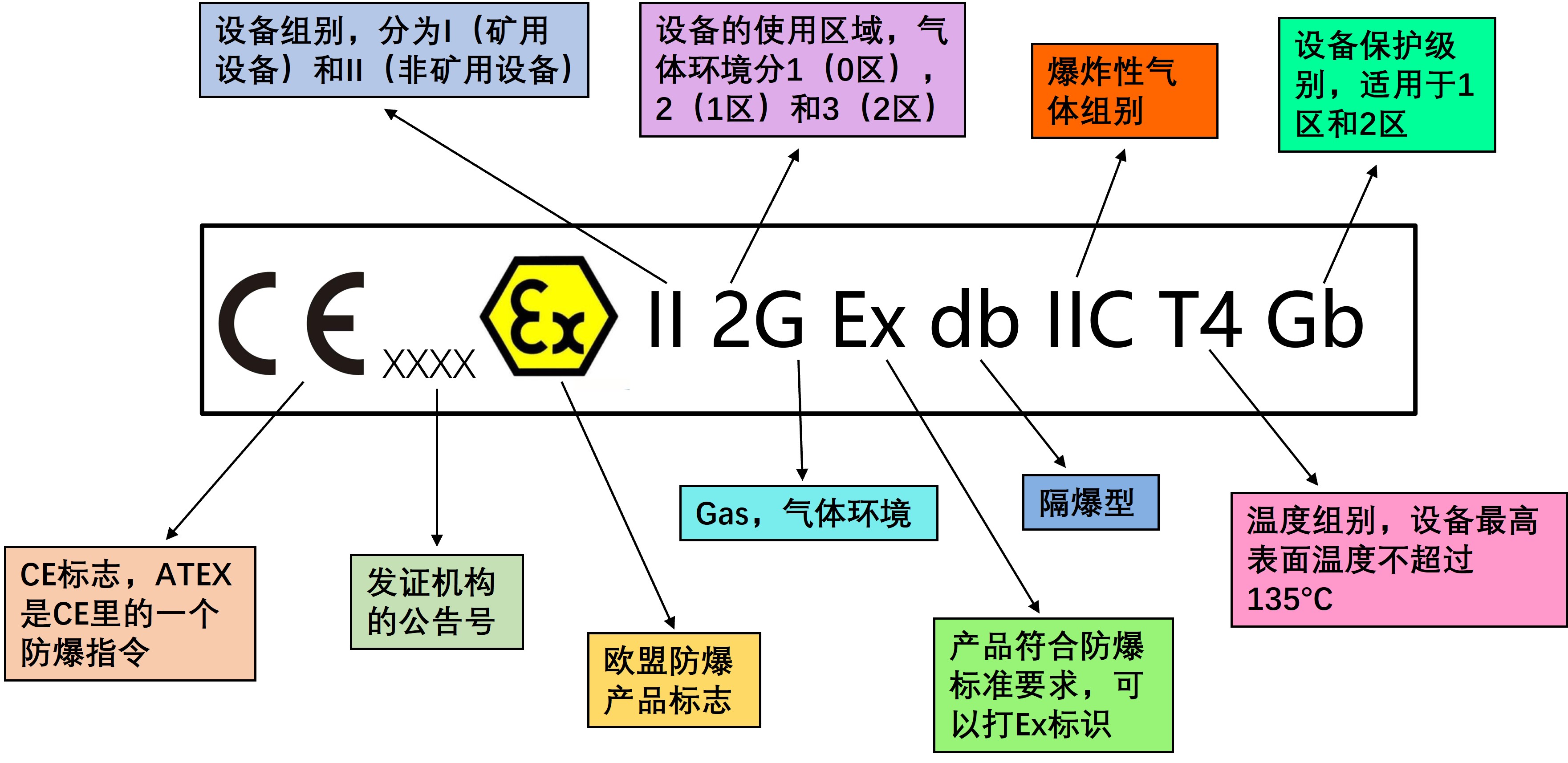
With the rapid development of China's economic construction and the increasing scale of industrial production, the issue of explosion prevention has become more important. Explosion proof electrical products with diverse functions and varieties are widely used in various industries such as petroleum, chemical, and coal. Whether explosion-proof electrical appliances can operate stably and safely in various hazardous explosive environments during use requires strict explosion-proof testing before leaving the factory. Shenzhen Zhongnuo Testing Technology Co., Ltd. has rich experience in product design and testing in the field of explosion-proof. The following is an interpretation of the latest EU explosion-proof ATEX certification directive 2014/34/EU and related issues.
Explosion proof Directive ATEX 2014/34/EU
(Old Directive 94/9/EC)
ATEX originated from the French word "ATmosphere EXlosible". On March 23, 1994, the European Commission adopted the Directive "Equipment and Protective Systems for Potential Explosive Environments" (94/9/EC). This directive has been in use since 1996 and was enforced on July 1, 2003.
This directive covers both mining and non mining equipment. Unlike previous directives, it includes mechanical and electrical equipment, extending the potential explosive hazard environment to dust and flammable gases, flammable vapors, and mist in the air. This directive is commonly referred to as the ATEX 100A "New Method" directive, which is the current ATEX Explosion Protection Directive.
Manufacturers of equipment intended for use in potentially explosive environments can sell their explosion-proof equipment anywhere in Europe without considering additional requirements, by applying the ATEX directive provisions and affixing the CE mark.
There are three prerequisites for applying this instruction:
1. The device must have its own ignition source;
2. Expected to be used in potentially explosive environments (air mixtures);
3. Under normal atmospheric conditions.
This instruction also applies to components necessary for safe use, as well as safety devices that directly benefit the safe use of equipment within the scope of application. These devices can be installed outside of potentially explosive environments.
ATEX2014/34/EUThe instruction divides the equipment into three categories based on the protection level of the installed equipment:
Category 1- Very high level of protection
Category 2- High level of protection
Category 3- Normal level of protection
If the device is used in zone 0, 1, or 2, the category number is followed by the letter G (gas, vapor/mist):
Zone 0, Zone 1, Zone 2
1G devices, 2G devices, 3G devices
If the device is used in zones 20, 21, or 22, the category number is followed by the letter D (dust):
Zone 20, Zone 21, Zone 22
1D devices, 2D devices, 3D devices
Zone 0: zone 0, Places where explosive gas environments occur continuously or exist for a long time, and the duration of hazardous environments is greater than 1000 hours per year.
Zone 1: zone 1, In places where explosive gas environments may occur during normal operation, the duration of hazardous environments is between 10-1000 hours per year.
Zone 2: zone 2, During normal operation, it is impossible to have an explosive gas environment. If it does occur occasionally and only for a short period of time, the hazardous environment will exist for less than 10 hours per year
(2) ATEX Directive 1999/92/EC
ATEX 1999/92/EC and ATEX2014/34/EUDirective Parallel is a minimum requirement for improving the health and safety protection of workers in potentially explosive hazardous environments (1999/92/EC), also known as ATEX 137, which specifies the minimum requirements for improving the health and safety protection of workers in potentially explosive hazardous environments.
This means that based on the assessment of the risks involved, employers bear a significant amount of responsibility:
1. Prevent the formation of explosive environments in the workplace or avoid igniting explosive environments;
2. Conduct a hazard assessment of explosive environments and ignition sources;
3. Divide the workplace according to the frequency and time of explosive environments;
4. Mark the area with symbols (Ex symbol) at the entrance;
5. Establish and maintain an explosion-proof document;
6. Select ATEX compliant hazardous areas based on the intended use2014/34/EUThe equipment required by the instruction.
ATEX 1999/92/EC regulations:
Only Class 1 equipment can be used in Zone 0 locations; Only Class 1 and Class 2 equipment can be used in Zone 1 locations; Only Class 1, 2, and 3 equipment can be used in Zone 2 locations.
This directive specifies the responsibilities of employers rather than manufacturers.

New Explosion Protection Directive 2014/34/EU Explanation
The new version of the Explosion Protection Directive 2014/34/EU was published in the EU Official Journal on March 29, 2014 and came into effect on April 18, 2014. The new explosion-proof directive 2014/34/EU will be officially implemented on April 20, 2016, and the old directive 94/9/EC will also be replaced accordingly. With the update of the directive, the European Commission will implement the explosion-proof directive regulations based on the new legislative framework (NLF).
The new version of the directive introduces a new legislative framework (NLF) that provides more detailed provisions on the obligations of distributors, while maintaining the same product scope, product classification, basic safety requirements, and consistency assessment process. At the same time, under the new NFL architecture, the requirements for announcement agencies in the certification process are more refined, and the responsibilities of agencies in the certification process are more clearly defined.
What are the changes in the new instructions
Q:Has there been any change in the product scope of the new explosion-proof directive 2014/34/EU?
A:The overall situation remains unchanged. Compared to the old instructions, the only difference is the wording, but the content remains consistent.
Q:When will the new version of the explosion-proof directive be used?
A:The new version of the directive was released on March 29, 2014; Effective on April 18, 2014; Implemented on April 20th, 2016.
Q:When can the certificate for the new explosion-proof directive 2014/34/EU be issued?
A:The new version of the directive certificate can only be issued from April 20, 2016. Prior to this date, the notified body can only make relevant preparations and is not allowed to issue certificates for the new version of the directive. Prior to this date, the notified body could only issue certificates for the old version of the Explosion Protection Directive 94/9/EC.
Q:When the new version of the Explosion Protection Directive 2014/34/EU is officially implemented, are the certificates of the old version of the directive valid?
A:Still effective. As long as the certificate of the old version of the explosion-proof directive 94/9/EC is still valid, the certificate will remain valid.
Q:What should I pay attention to when using the old version of the explosion-proof directive 94/9/EC certificate after April 20, 2016?
A:Customers holding certificates of the old version of the directive need to pay attention to providing a declaration of conformity for the new version of the explosion-proof directive 2014/34/EU when providing a declaration of conformity.
Q:After April 20, 2016, can certificates issued according to the old version of the directive be reviewed annually or updated for renewal?
A:sure. The annual review or renewal of certificates will be carried out in accordance with the new instructions.
Q:Can the manufacturer sign and provide a declaration of conformity based on the new version of the directive on April 20, 2016?
A:no way. The compliance declaration related to the new version of the directive can only be signed from April 20, 2016 onwards

|
||||||
|
||||||